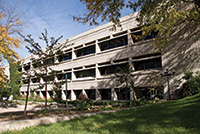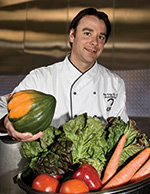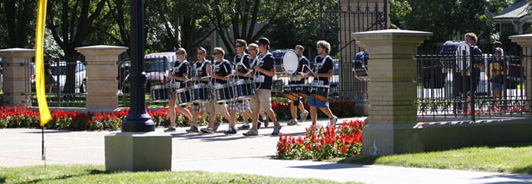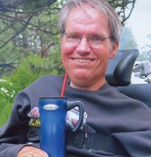Campus Scene
Behind the Building
 When Candelaria Hall was dedicated in 1974, it helped usher in a new era in education. “It was part of the new campus initiative at the time,” says UNC History Professor Michael Welsh, the keynote speaker of a campus presentation this fall to celebrate the building’s 40th anniversary. “It was a place created to highlight the emphasis on social and cultural themes in academia and study families, communities and societies.” Candelaria is home to the College of Humanities and Social Sciences and 15 schools, departments or programs in the liberal arts.
When Candelaria Hall was dedicated in 1974, it helped usher in a new era in education. “It was part of the new campus initiative at the time,” says UNC History Professor Michael Welsh, the keynote speaker of a campus presentation this fall to celebrate the building’s 40th anniversary. “It was a place created to highlight the emphasis on social and cultural themes in academia and study families, communities and societies.” Candelaria is home to the College of Humanities and Social Sciences and 15 schools, departments or programs in the liberal arts.
Fast Facts
- The building was named after Professor Martín Candelaria the first native Spanish speaker to be hired at the university. From 1948-1963, he taught Spanish and helped establish the foreign languages department. Before arriving on campus, the Colorado native, born in 1897, served in France during World War I.
- Adorning the building’s staircase, a large mural by famous artist Leo Tanguma, who infused movement into the multi-level design, tells the story of Candelaria’s life.
A World with 100 People
What if the world had only 100 people living in it? What would it look like based on characteristics of the current population? Thanks to Professor Emeritus John Vonk and alumnus Fritz Erickson, there’s well-researched answers.
Vonk and Erickson collaborated in 2006 to provide the framework for 100 People: A World Portrait. The tidy snapshot that continues to be updated is based on projections extrapolated after sifting through data for 15 variables that “represent the most common characteristics” among the 7 billion of us on the planet.
Criteria like language, sexuality and race are mathematically estimated through the survey. Vonk says that the idea is to think about all of the different traits each human has.
“Once you get past the first layer of gender, the survey becomes extremely complex,” he says.
Over the years, the 100 People Foundation, which funded the study, has traveled worldwide to collect and share stories. At 100people.org, teachers can learn how to make it a class project and nominate an individual who represents one of the 100 people.
50 would be female, 50 would be male
26 would be children, 74 adults, 8 of whom would be 65 and older
60 Asians, 15 Africans, 14 people from the Americas, 11 Europeans
33 Christians, 22 Muslims, 14 Hindus, 7 Buddhists, 12 people who practice other religions, 12 people who would not be aligned with a religion
12 would speak Chinese, 5 would speak Spanish, 5 would speak English, 3 would speak Arabic, 3 would speak Hindi, 3 would speak Bengali, 3 would speak Portuguese, 2 would speak Russian, 2 would speak Japanese, 62 would speak other languages
83 would read and write, 17 would not
7 would have a college degree, 22 would own or share a computer
77 people would have shelter, 23 would not
1 would be dying of starvation, 15 would be undernourished, 21 would be overweight
87 would have access to safe drinking water, 13 people would have not
 Overheard
Overheard
“The food here is the best of any college we go to.”
— Peter Steinberg, head coach of the USA Rugby women’s team, which has trained and competed on campus the past two summers, on the quality of food at UNC.
UNC Executive Chef Aran Essig, a self-described “foodie” who loves to travel in search of cuisine to incorporate into the extensive and ever-changing campus dining menus, shares a recipe and culinaryrelated information at www.unco.edu/dining/chef
Sports
Follow the Bears at www.uncbears.com and remember to sign up for free access to Big Sky TV to catch game coverage at www.americaonesports.com/bigsky.asp
Ask the Expert
What are a few fun facts about the state of Colorado?
History expert, author and UNC faculty member Mary Borg has countless Colorado facts to share. The instructor of UNC classes on Colorado and American history provided some of her favorites as the 38th state in the union celebrated its 137th anniversary Aug. 1:
- No one had ever heard of Colorado in 1859 when gold was discovered in the Dry Fork of Cherry Creek. The area was part of Kansas. But people had heard of Pikes Peak since Zebulon Pike named the mountain near present-day Colorado Springs in 1807. And so, in general confusion, Colorado’s gold rush was labeled The Pikes Peak Gold Rush and folks painted “Pikes Peak or Bust” on their wagons.
- To Colorado miners, Tommyknockers, the spirits or ghosts of dead miners, were real. When they knocked — tap tap tap — they were warning about danger, like a mine collapse or the presence of poisonous gases in the mine. Or even better, miners said, these two-foot tall, bearded and wrinklefaced Tommyknockers were informing a miner where a rich vein of ore was just waiting to be discovered. They were helpful pranksters.
- Colorado has more ghost towns on the Eastern Plains than it has mining ghost towns in the Rocky Mountains.
- On Black Sunday, April 14, 1935, the worst dust storm of all the “black blizzards” hit the Great Plains. The Dust Bowl storm carried away twice as much dirt as was dug out of the earth to create the Panama Canal. The canal took seven years to dig; the duster lasted a single afternoon. More than 300,000 tons of Great Plains topsoil blew away.
- The area where the Cherry Creek Shopping Center is today started out as a place to “mine” sand from a huge pit, which then became Denver’s dump. After the sandpit was filled in with garbage, the shopping center was built — an excellent example of land reclamation.
- The first edition of the Rocky Mountain News, Colorado’s first newspaper (now defunct), published on April 23, 1859, locates the newspaper as being from Cherry Creek, K.T. (Kansas Territory).
- In 1955, there were four TV stations broadcast from Denver. On Sunday, Sept. 4, 1955, programming began at 10:45 a.m. and ended at 11:25 p.m. The programs included Face the Nation and Meet the Press and a show called Sounding Board, which that Sunday was airing a segment called “What are we doing about alcoholism in Colorado?”
- After World War II, Denver became known as Washington, D.C., West because the city housed so many federal offices.
— As told to Amy Dressel-Martin
Borg is interviewed about gifts Colorado has given to the country through the years, including serving as the inspiration for “America the Beautiful,” at www.unco.edu/news/?5552







